Table of Contents
What is Bracing in construction?
Bracing is a construction method used to stabilize the building structure against lateral forces. It increases the capability of building structures to withstand lateral load due to wind and earthquakes.
Bracing is essential in earthquake-resistant buildings to keep them standing. In a frame structure beams, and columns bear vertical loads, whereas the bracing bears horizontal loads.
What is the purpose of bracing?
The primary purpose of providing bracing is to provide stability to the structure and preclude the collapse of a structure due to earthquake or wind or effect of moving load such as a crane.
It ensures the safety of the building. The primary function of bracing is to transfer horizontal forces from the frame to the foundation of the building.
Types of Bracing System
- Horizontal Bracings
- Vertical Bracings
Horizontal Bracing System
The horizontal bracing system includes bracing at each floor in a horizontal plane offers load paths for the lateral forces to transfer them to vertical bracing planes.
It is essential at each floor level. Still, the floor system may provide sufficient resistance, but roofs may demand bracing.
This bracing system aims to transmit lateral loads from columns at the structure’s perimeter to the vertical bracing planes.
The pressure of wind forces on the structure’s cladding generates horizontal forces on columns at the edge.
Horizontal bracing has two main types, which are regularly practised for multistory steel structures:
- Diaphragms and
- Discrete triangulated bracing.
Diaphragms
There are different floor systems, and some provide excellent horizontal diaphragms such as composite floors. In comparison, precast concrete slabs require precise measures to serve their purpose satisfactorily.
For instance, steelwork and the precast concrete slab should join together correctly to avoid relative movements.
Discrete triangulated bracing
It is used if it is not possible to use floor systems as a horizontal bracing system. It consists of triangulated steel bracing positioned in each orthogonal orientation.
The horizontal bracings are positioned between supports, which generally are vertical bracings. About bracing at roof level, a wind girder is utilized to withstand horizontal forces at columns’ top.
Vertical Bracing System
A vertical bracing system is used in a vertical plane in the middle of column lines that offers load paths for moving lateral loads to the ground level.
This system gives lateral stability by transmitting horizontal loads to the foundations and resists the structure’s overall sway. Vertical bracings are positioned between lines of two columns.
In frame structure building, for withstanding torsion about a vertical axis and for bracing both directions in plan minimum of three vertical bracing planes are required.
Types of Bracing
Based on shape bracing may be classified are as follows.
- Singal Diagonals
- Cross Bracing or X Bracing
- K Bracing
- V Bracing
- Chevron Bracing
- Eccentric Bracing
Single diagonals
In this bracing, triangulation or trussing is created by placing diagonal structural components into rectangular areas of a structural frame to stabilize the structure. It should be adequately resistant to tension as well as compression if single bracing is utilized.
It is planned to withstand both compression and tension forces. The arrangement of diagonal bracing is shown in the image below.
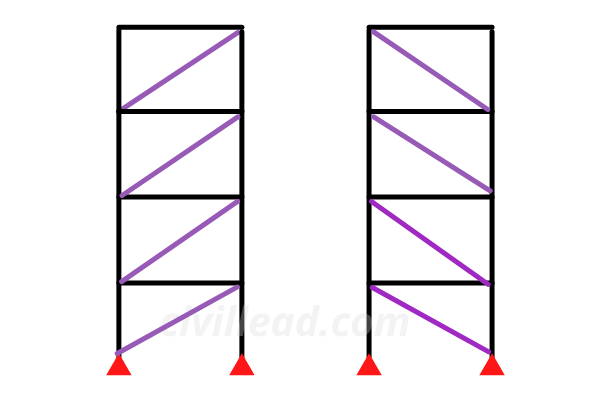
Bracing components are typically positioned at about 45° because they offer an effective system than others. They provide compact and robust connections between the bracing element and beam-column juncture.
If the inclination of the bracing component is less than 45° from vertical, then structure sway sensitivity may increase. In contrast, a broader bracing member configuration provides more significant structural stability.
Cross Bracing or X Bracing
Cross-bracing or X-bracing utilizes two diagonal components intersecting each other and are required to resist tension only. Depending on the direction of loading, a single brace acts to oppose sideways forces promptly. Resulting in steel cables may also be provided for cross-bracing.
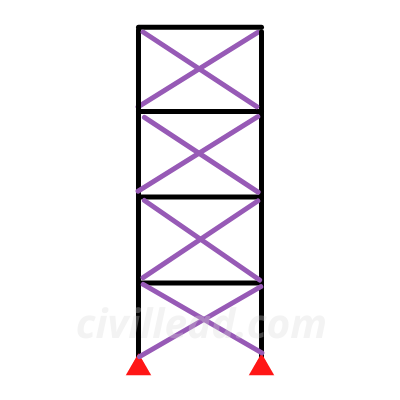
Cross bracing on the outer building front can interrupt the position and function of openings (door and window), resulting in more significant bending in floor beams.
Braces are slight and oppose only tension forces, which will not fight compression forces. Thus, tensile components give required lateral stability, and the floor beams function as a part of the bracing system.
K Bracing
These braces attach to the columns at the middle height. Frame with these braces are more flexible and provide openings in the outer face, resulting in less bending in the floor beam.

Usually, k bracing is prevented in seismic areas because in case compression brace buckles, there is a possibility for failure of the column.
V Bracing
This bracing consists of two diagonal components moving down from the top two corners of a horizontal part and meeting at a centre on the lower horizontal component to form a v shape.
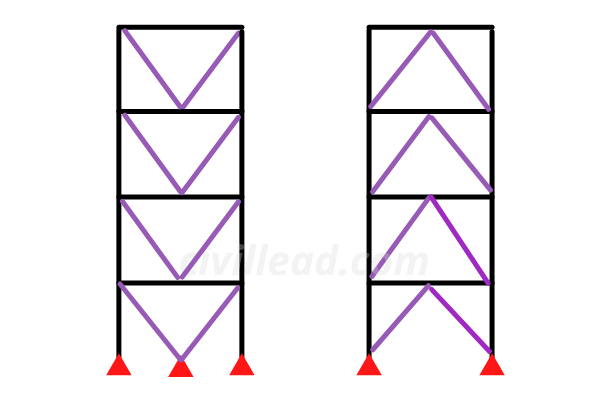
An Inverted V-bracing, also termed chevron bracing has two components that meet at the centre on the top horizontal element.
Eccentric Bracing
This bracing is generally provided in seismic regions and is comparable to V-bracing. Still, bracing components don’t meet at a middle point, having a gap between them at the top connection.
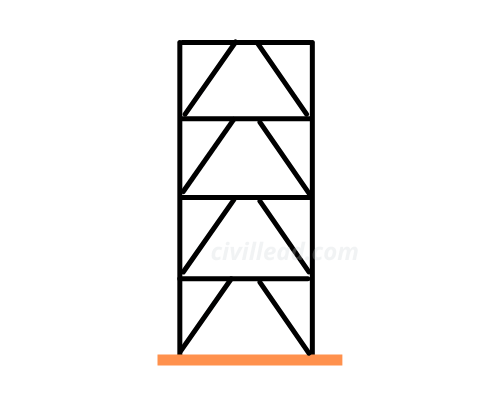
Bracing components join distinct points on the horizontal beams. The ‘connection’ between the bracing elements helps absorb the energy coming from seismic activity via plastic deformation. For bracing a frame, eccentric single diagonals may also be utilized.
Bracing For Multistorey Building Frame
Multistorey buildings subjected to horizontal forces such as wind or earthquake have problematic and highly indeterminate structural behaviour. There are three recognized joints between beam and column
- Simple or flexible,
- Semi-rigid, and
- Rigid joint
Frame with flexible joints have no internal resistance against horizontal loads, and external bracing members must be used for this purpose.
If the joints are rigid enough, so that angle between them doesn’t change, the structure as a whole will be able to resist the lateral forces. In general, the most common way to brace building of low to medium height is through the use of
- External Bracing
- Shear wall
- Moment Resisting Connection Between Beams and Columns.
If cross braces are used, the rigidity of joints is not necessary. However, such bracing is possible only if there are no openings like door and window in panel braced.
The image below shows different bracing arrangments and positions of an opening indicated by the dotted lines.
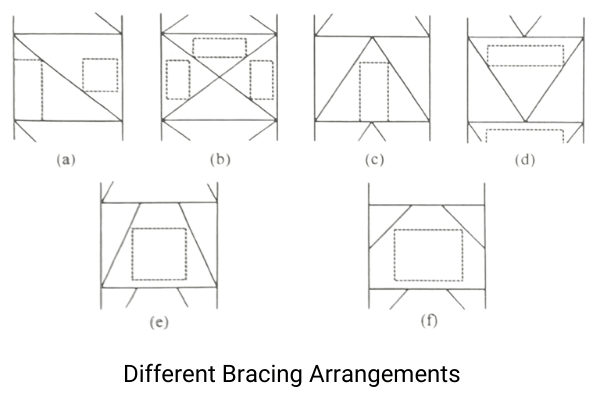
The diagonal bracing shown in the image may permit large openings but is effective only when the direction of horizontal load does not change.
Suppose the direction of horizontal load changes due to change in wind direction crossing bracing shown in the image may be used.
Such bracing forms a series of vertical trusses but is not preferred because it restricts the opening.
The K bracing shown in the image may be advantageous where only small openings are to be accommodated.
The bracing shown in the image permits large openings. Still, large openings can be provided by using knee bracing shown in the image.
These bracing forms cause encroachment that may not be tolerated, so moment-resistant connections (rigid joints) must be used to create a vierendeel truss.
A bent that is provided with any form of bracing is called braced bent.
Advantages of Bracing
- Bracing helps for retrofitting and strengthening an existing structure.
- The bracing system significantly influences the restriction to the relative floor-to-floor lateral displacement.
- Bracing System helps to reduce inter-story drift significantly.
- Bracing helps to resist wind and seismic force in a more excellent way.
- It has the flexibility to design to achieve the demanded strength and stiffness.
- A significant advantage of providing bracing is the lowering in lateral displacement. In this case, concentric (X) bracing performs better than Eccentric (V) bracing.
- It is easy to install, engages less space, and is economical.
Disadvantages of Bracing
- Altitude-dependent differences in seismic region.
- It has a restricted span length of 40 feet when reinforced.
- Skilled labourers are required for the construction of the braced structure.
Also, Read
Difference Between Load Bearing Structure And Framed Structure
What is a Column? Types of Columns, Reinforcement, Design Procedure
Grade Beam – Grade Beam Foundation, Construction Process, Advantages & Disadvantages
Difference Between Pre tensioning and Post Tensioning